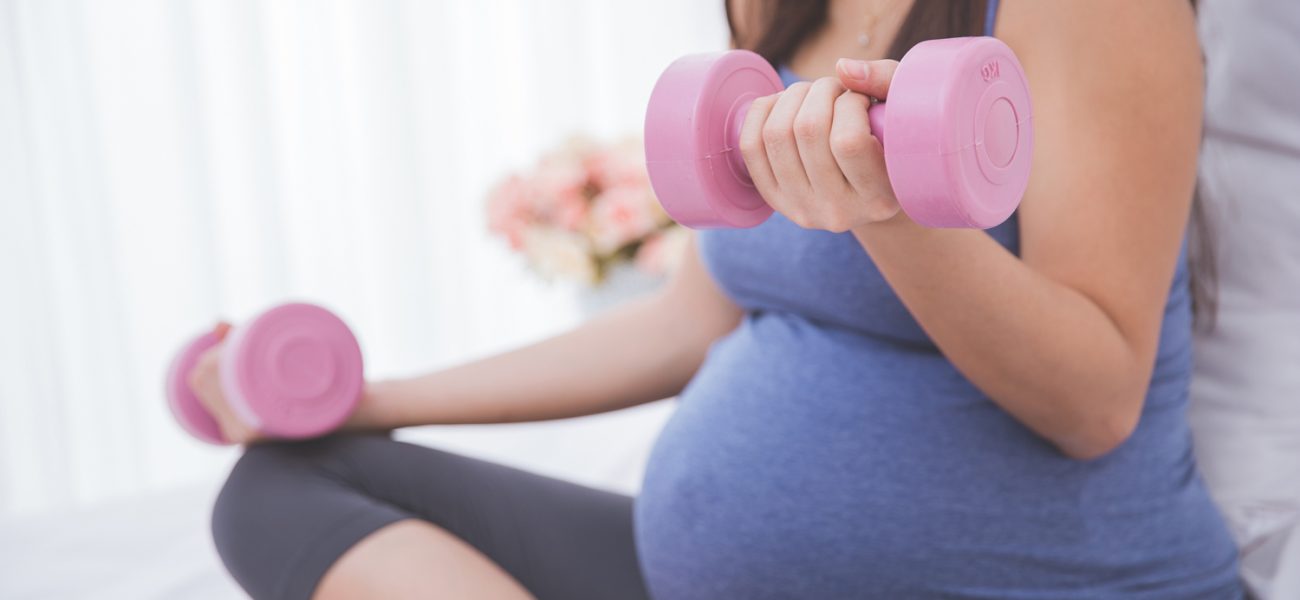As amazing as it is to bring a new life into the world, let’s be honest – pregnancy can be tough. Your back aches, your ankles might be swollen and it can be tricky to sleep, and that’s not mentioning the psychological side of things. Thankfully, these symptoms can be lessened with some healthy exercise, and you’ll even enjoy a lovely mood boost, lower BMI and an easier postpartum recovery! However, as with everything surrounding pregnancy, it’s important to do your research and check what types you can actually enjoy and find out what your limitations are.
Can anyone exercise while pregnant?
For most pregnant women, exercising is safe and healthy for you and your baby (but it’s best to get the okay from your GP before hitting a new workout routine). It doesn’t matter if you were an iron woman or a sofa slacker before now, you can still benefit from getting active during pregnancy. Plus, despite misconceptions, exercise won’t affect your chances of having a miscarriage, a premature baby or a baby born with low birth weight. However, as Baby Centre instructs, always let your exercise teacher know that you’re pregnant (or, ideally, choose classes tailored to pregnant women).
Be prepared with pregnancy exercise kit
Wear loose, breathable, stretchable clothes and a sports bra that supports your breasts without pinching, as well as a belly band if desired. Warm up before and cool down after your prenatal workout – this ensures that your heart and circulation aren’t suddenly taxed and reduces the chance of injury. Finally, keep a snack handy – regular exercise for longer than 45 minutes can lead to low blood sugar, so enjoy a light protein-carb combo snack before and after pregnancy workout sessions.
Stay hydrated when exercising
When you’re pregnant, your body temperature may fluctuate more than usual when you exercise, so keep your workout in an air-conditioned or well-ventilated environment, and make sure you drink enough water so that you don’t feel thirsty. For every half hour that you work up a sweat, down at least an extra full glass of water (or more if you’re seriously sweating). Start sipping 30 to 45 minutes before you begin exercising, and continue to do so during and after your workouts.
Take care to avoid injuries
When you’re pregnant, your body produces a hormone that causes your ligaments and tendons to soften and become more elastic – in fact, it can remain in your body for months after childbirth. While this makes you more flexible, there’s also less support for your joints, and a high impact exercise program or sudden change in directions could increase your risk of straining ligaments or tendons. Therefore, it’s better to avoid vigorous exercise like jumping, bouncing or jerky motions, as well as regular physical activity that require a deep extension of joints. Likewise, avoid exercises that have you lying flat on your back for a prolonged period of time, especially during the third trimester, as the baby could press on your main vein and reduce the blood flow to your heart, causing low blood pressure and making you feel faint.
What warning signs are there that you should stop exercising?
When you’re being physically active, pay attention to your body and how you feel: a little sweat is good; getting drenched isn’t – never exercise to the point of exhaustion when you’re expecting. You should feel energised, not drained, after you finish. Similarly, pain is a red flag. As the American College of Obstetricians and Gynaecologists explains, if you experience bleeding or fluid leaking from the vagina, trouble breathing, dizziness, muscle weakness, swelling in your lower legs or regular, painful contractions, call your doctor or obstetrician.
What are some exercises you can do while pregnant?
Healthy pregnant women need at least two and a half hours of moderate-intensity aerobic activity each week. Aerobic activities are ones that make you breathe faster and increase your heart rate, while moderate-intensity means you’re active enough to start sweating. You should be able to hold a conversation without gasping for breath while doing this prenatal exercise routine – if you can’t, your exercise intensity may be too high. This might sound like a lot, but you don’t need to do those two and a half hours at once. Instead, break it down into manageable time periods.
Cycling
Cycling is a good low-impact aerobic exercise, but as your bump grows, your balance will change, which could mean you are more likely to fall off. Therefore, it may be better to stick to a stationary exercise bike in the gym or as part of a group session – this way, you can pedal at your own pace without the risk of falling or putting pressure on your ankle and knee joints. Just adjust the handlebars so you’re more upright and not leaning forward to avoid adding pressure on your lower back.
Yoga and Pilates
Pregnancy-appropriate versions of yoga and Pilates focus on strengthening your core and muscles with low- to no-impact, which will help ease backaches and improve your posture as well as your flexibility – all great preparation for the birth. Look for a pregnancy yoga or pregnancy Pilates class specifically tailored to pregnant women, or ask your regular yoga instructor to modify the poses so they’re safe for you, by avoiding deep backbends as well as full inversions like handstands and headstands owing to potential blood pressure issues.
Running and walking
If you were a runner or jogger before you got pregnant, it’s safe and healthy to continue during your pregnancy as long as you feel okay – your baby will not be harmed by the impact or the movement. However, as we list in our seven tips for running during pregnancy, consider your route carefully to reduce the risk of falling. Choose an area that is fairly flat, avoid steep hills and lots of steps. Also, consider the time you go running. During the summer months, early mornings or late evenings may be better as it is cooler. Remember you are trying to maintain your fitness levels, rather than setting a new personal best. Don’t try to run for too long either; up to 30 minutes is enough.
Strength exercises
Strength training involves moving your muscles against some kind of resistance, such as free weights or your own body weight. If you’ve never done strength training before, it’s important that you speak to a trained professional, such as a physiotherapist or gym instructor, so that they can show you the correct and safest techniques to use before attempting to lift weights on your own. If you have done strength training before, opt for more reps using a lower weight than usual. You might also want to switch to machines that limit your range of motion to reduce any chance of injury.
Swimming
Swimming and aqua aerobics are excellent forms of exercise to do when you’re pregnant as the water helps to support your weight and won’t put any extra stress on your joints and ligaments. Plus, aquanatal classes are a popular and fun way to meet other mums-to-be. However, as Tommy’s PregnancyHub points out, you may need to avoid breaststroke because it can cause back pain if your spine is not aligned correctly. Likewise, be careful when walking on slippery poolsides, and step or slide into the water rather than diving or jumping in.





















